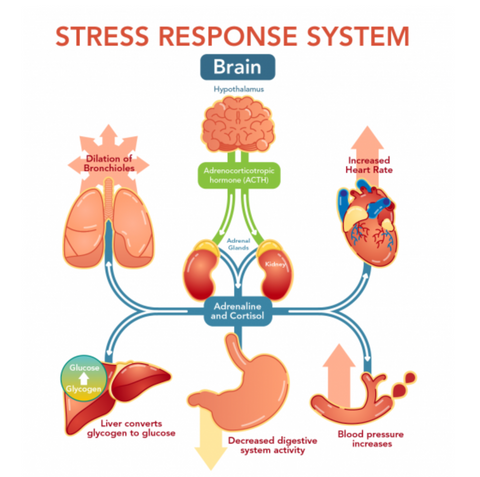
Stress and the Autonomic Nervous System
Share
So what is the autonomic nervous system? To answer this question we need to cover some basic neuroanatomy, starting with the difference between the central nervous system and the peripheral nervous system. The central nervous system (CNS) includes the brain and spinal cord, while the peripheral nervous system (PNS) consists of the neuronal pathways that connect to the CNS and communicate sensory information to the brain and allow the brain to send motor signals to the rest of the body. The autonomic nervous system consists of the involuntary physiological processes of the PNS including regulation of blood pressure, heart rate, respiration, digestion and sexual arousal. Within the autonomic nervous system, we have the sympathetic nervous system (SNS), the parasympathetic nervous system (PSNS) and the enteric nervous system (ENS).

Sympathetic Nervous System Activation: the Impacts of Stress
The SNS connects the brain and spinal cord (CNS) to nearly all the tissues of the body. This is the part of our nervous system activated when we are in a stressful situation. When activated, the body experiences increased heart rate, and blood pressure, and a general excited state resulting in increased attention and decreased digestion. This is accomplished through the release of norepinephrine, a form of adrenaline, released onto body tissues. We need this activation in stressful situations so we can react in a timely manner and survive a potentially dangerous event. However, today our world is full of stimulation that can activate the SNS in response to situations that may not be life threatening or even potentially harmful. For example, even something mundane like prolonged time in front of screens can keep the body in a state of sympathetic activation, despite the fact that the body is in no immediate danger. Chronic over activation of the SNS has been studied and correlated with chronic disease states including hypertension (chronic high blood pressure), ischemic heart disease, as well as a plethora of other chronic diseases including type 2 diabetes, and kidney disease. Yikes!
Another important system in the body that is activated by stress is what’s called the hypothalamic-pituitary-adrenal axis or HPA axis. This system involves the release of cortisol AKA the stress hormone. Adrenal fatigue is a major contributor to chronic disease.
It’s hard to avoid stressful situations in our modern world, especially when so many of us encounter them on a daily basis. So how do we counterbalance the effects of stress and prolonged activation of the SNS? To answer this question we need to look at the parasympathetic nervous system (PSNS).
Parasympathetic Nervous System Activation: Rest and Relaxation

Obviously some amount of the stress of daily life is unavoidable, but it can be manageable if we take the time to tend to our nervous systems and make sure we spend time in a parasympathetic mode of being. So what exactly does PSNS activation look like?
The PSNS is active when the body is in a state of calm and is at rest. It lowers blood pressure and heart rate and activates digestion and peristalsis (contraction of the intestines to move food along the digestive tract.) Nearly 75% of the PSNS is made up of the vagus nerve and the tissues it innervates, which include most of the digestive system, including the colon. The vagus nerve plays a large role in the body’s immune response, innervating the major organs of the body and acting as an alert system if “invaders” like viruses, bacteria, and allergens are detected in the body. This is an important point, because if the body is in a state of SNS activation, the vagus nerve is much less sensitive and is therefore less likely to detect a viral or bacterial invasion of the body, lowering immunity and increasing the likelihood to get sick.
Everyone needs a little help with their stress levels. When focusing on healing and longevity there are a few things to focus on. Diet, exercise, sleep and stress! Help your body manage stress with our Daily Anti-Stress Kit.

Order Your Anti-Stress Kit Here ->
Tips For Reducing Stress
Proper digestion and immune function are no doubt key pillars of good health, and we can’t have them without activation of the PSNS. So what are some ways to shift our nervous system into this more relaxed state and promote healing?
- Spend time in nature - Studies show that viewing plant-filled spaces, even manmade ones, after a stressful event can help return the nervous system to a relaxed and parasympathetic state.
- Deep breathing - Taking slow deep breaths can trigger the PSNS and is an effective way to quickly switch our nervous system to a more relaxed state. Try taking a breath in for a slow count of 4, holding it for 4 counts, exhale for 4 counts, and hold the breath again for 4 counts. Repeat this up to 10 times and take notice of how you feel afterwards.
- Yoga, tai chi, or other mindful movement - Stress has been shown to cause inflammation in the body causing negative changes in vasculature and even affecting our genetics! Yoga has been shown not only to mitigate these effects, but to also prevent these negative physiological effects.
- Exercise - Numerous studies have shown the positive effects of exercise on physiology, including reduced stress and improved recovery from stress. However, it’s important to note that some studies have shown that moderate intensity exercise is more beneficial when compared to high intensity exercise which can actually cause unwanted oxidative stress in the body.
- Nutrition - Of course we can’t forget about our digestive system! Studies have shown that gut bacteria can actually activate the vagus nerve, thus activating the PSNS. One of the best ways to develop healthy gut bacteria is by eating a wide variety of plant-based foods, so don’t overlook your diet when trying to counteract the effects of stress. Focusing on healthy nutrition is a key to heal chronic disease.
- Meditation - Like other mindfulness practices, meditation has been widely studied as an effective tool to counter the effects of stress, likely due to its stimulating effects on the vagus nerve.
- Relaxation and self-care - It’s easy to neglect our bodies in this modern day world, but taking the time to take a bath, get a massage, or dance and listen to soothing music can go a long way in reducing stress. Remember, you are worth the time and effort and taking just a few minutes a day to counteract the stress we experience can be highly beneficial.
About Author

Stephanie is the current fulfillment director and kitchen supervisor for Organic Pharmer. She studied Neuroscience at University of California, Irvine before studying Naturopathic Medicine for 2 years at National University of Natural Medicine in Portland, Oregon. She also spent 3 years studying East Asian Medicine at the same university.
